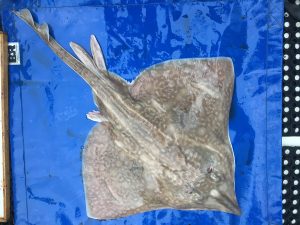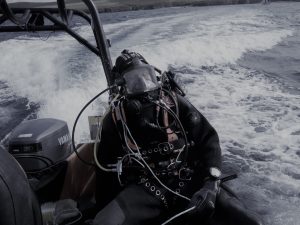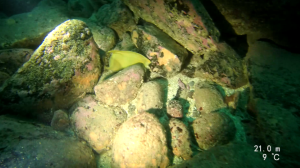Projects
TAG AND RELEASE ANGLING
The Orkney Skate Trust manages a mark recapture programme for Flapper Skate with dedicated angling trips when funding permits. The practise of mark recapture has been used in fisheries science, particularly in Elasmobranch research for many years and is particularly well suited for this group of animals owing to their robustness but also low overall population size as compared to teleost fish.
During mark recapture an animal is captured and key measurements and biological data are taken, recorded along with environmental, and spatial data that includes location, depth and time. The animal is then tagged with a small specialist dart which is indelibly marked with a unique number as well as contact details a
nd “do not Kill”. This unique number will remain with the animal indefinitely until recapture in time – where the same data will again be recorded. Finally photographs and a DNA skin sample is taken of the individual fish.
This research gives us crucial information of Flapper Skate growth rates over time – indicating how healthy the animal is and their ability to continue to survive and reproduce. The data gives us valuable information on how the animal is using habitats and how the animal has moved during the period of liberty. The overall dataset allows us to be certain of population size and dynamics as the number of individual fish are tagged – enabling us to better understand the health of the population of Flapper Skate in Orkney.
Ultimately the data is invaluable to demonstrate out-right the presence and health of the population of Flapper Skate in Orkney and is used to influence planning decisions within Environmental Impact Assessments as well as influence policy and inform national fisheries management and conservation organisations.
In 2020 Orkney Skate Trust has started to see the emergence of the Blue Skate in Orkney waters – a species that typically prefers warmer water than the Flapper Skate.
DIVER OBSERVATIONS
The use of divers – Recreational & Working Divers have been a valuable source of information regarding Flapper Skate in Orkney. The Orkney Skate Trust has a good knowledge of diving activity within Orkney and has many records of Flapper Skate sightings, as well as sightings of live egg cases laid in situ on the seabed.
The OST records the location of the skate sighting and egg cases, as well as the water depth and other information available – such as an estimation of the size and the sex of the animal or number of egg cases.
The divers report and specific behaviour of the animal such as if the resting, swimming, feeding or if the animal was actively inquisitive of the divers activity. The information is catalogued along with the time of the year for reference.
EGG CASE RECORDS
Along with the live In Situ egg cases reported from diving activity – the Orkney Skate Trust records information on spent egg cases that are washed ashore. The Orkney Skate Trust relies on the network of members and members of the public to submit records and to date has the worlds largest number of recordings of egg cases of Flapper Skate.
The number of egg cases are recorded at specific locations along with the time of year – the egg cases are then removed from the shoreline to prevent double counting and erroneous data.
Following storms significant numbers of egg cases are washed ashore and on occasion a small number of egg cases have the remains of embryos and or egg case fluids inside. These records are important in understanding the location of the laying sites at the source of the egg cases as well as assisting with greater knowledge of the reproductive biology of the Flapper Skate. DNA samples are extracted for further analysis and images recorded.
The diver sightings, particularly of the egg cases in situ are very important to assist with the conservation programme. Where areas of egg cases are observed – this information is used to influence planning decisions and policy and inform EIA.
DNA DATABASE
Maintaining a library of DNA of individual animals from the tag and release programme, as well as from embryo washed ashore during storms is an important next step in understanding the biology and movements of Flapper Skate, in Orkney but more so over their geographical range.
A small clipping of the skin is taken and stored for analysis at a University. The information will be used to characterise the populations of Flapper Skate that exists around the UK shores and further afield. It would be invaluable to understand if the populations are residents to a particular area and to what level of mingling individuals or populations engage within the areas of their refuge. The potential for good research and effective conservation of Flapper Skate using DNA analysis is very high and more work is needed as soon as possible to further this next step.
Results
Through to 2021 OST have:
- Counted over 21,000 spent Flapper Egg cases washed on Orkney Shorelines
- Recorded over 200 sightings of Flapper Skate around Orkney
- Recorded the proven locations of inshore egg laying areas – establishing the habitats skate are using and publishing the work
- Documented Flapper Skate in the wild
- Tagged and Released 120 individual Flapper Skate in Orkney
- Tagged and Released commercial captured bycatch Flapper Skate in Northern North Sea
- Started a DNA sample data bank of Flapper Skate
- Recorded the first records of Blue Skate in Orkney inshore waters and taken DNA samples
- Designed, built, deployed and tested multiple different BRUV frames in waters up to 100m
- Raised the profile of Flapper Skate through engagement within aquriums and the public, hatching a Flapper Skate in captivity.



